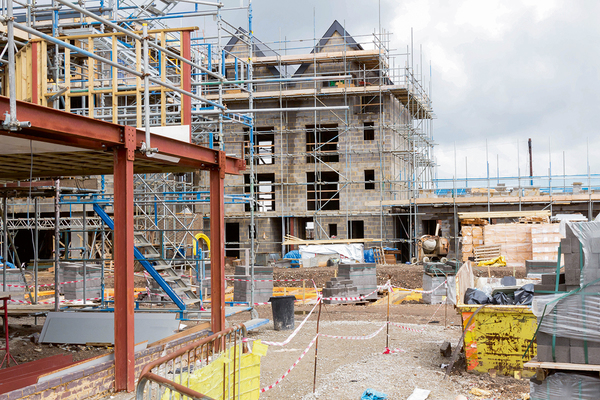Reinventing the wheel as multi-tenure developers
Housing associations have become true multi-tenure developers, says James Knight at Arcadis. Photography by Getty
Housing associations have evolved significantly over the past 10 to 15 years and are now recognised as major developers in their own right. It is difficult to pinpoint one particular catalyst that is responsible for this change, it is rather an amalgamation of gradual changes that has resulted in the emergence of this new breed of multi-tenure developer.
If any evidence is needed to demonstrate this, housing associations are now competing for and winning ‘house builder of the year’ awards, with Places for People winning one such award last year.
The erosion of grant for social housing, coupled with the administrative cost of compliance and deregulation, have driven and enabled housing associations to rethink and then restructure their business models.
The more progressive housing associations with smart finance directors took advantage of a rapidly appreciating asset base to leverage cheap finance for development.
They were able to recycle the proceeds from outright sale to access further development opportunities and deliver affordable housing without grant.
As this new way of doing business has developed, we have also witnessed the emergence of larger organisations through organic growth, stock transfer and significant industry consolidation. This has created some huge UK-wide organisations such as Places for People, with a stock of circa 180,000 homes and a development pipeline of 16,000 homes.
In London, we have recently seen mergers between Affinity Sutton and Circle to create Clarion, with a promise to build 50,000 new homes over the next 10 years, and between L&Q and East Thames, which have an aspiration to deliver 10,000 new homes each year. Provision at this scale places the housing associations firmly alongside major national house builders in the delivery of housing in the UK.
Big ambitions
The scale of these organisations and their social and development ambitions make them hugely important players in improving the prospects for homeownership among future generations.
It is widely recognised that to have an effect on affordability, about 300,000 units need to be completed every year. Given our inability to realise this aspiration over the past 20 years, it appears a near impossible target, and only with a disruptive restructure of planning and development could such numbers be achieved.
One could also question what ‘fixing’ the housing crisis would do to the many people who have huge mortgages based on the assumption that interest rates will remain low for ever and property prices will continue to rise inexorably.
Yet, the good news is that the number of new homes is gradually starting to creep up, thanks to the emergence of new players in the build-to-rent sector and the increased activity of housing associations.
This shift in the housing association model has presented challenges both internally, from a capability and capacity perspective, and externally in delivery. While the vision and aspiration of chief executives has been progressive, it takes time for the culture of the organisation to change and success will only be achieved through the creation of an organisational structure which is appropriate for the delivery of multi-tenure homes at this scale.
It is well recognised that there is a skills shortage within the industry and this is just as acute for technical professionals as it is for construction workers. Housing associations are in need of private sector expertise to deliver their new business models and unsurprisingly they are finding the same challenges in attracting and keeping these people as the private sector.
The skills shortage and capacity problems within the industry have been felt most acutely in the residential sector, resulting in rampant cost inflation and a loss of appetite for single-stage design and build tendering – the established delivery model for housing associations, reflecting their appetite for risk.
Housing associations have experienced a real difficulty in securing delivery of their schemes in the traditional manner, which has amplified the challenges that they face in delivering large programmes.
A better approach – and one with which we have delivered a huge amount of positive outcomes for our clients over the past 12 years – is collaborative or joint venture working.
Joint venture working with contractors and consultants enables housing associations to leverage the skills of the private sector’s expertise and experience to directly benefit their business models.
This allows the housing association team to remain lean and efficient and, provided the relationships are incentivised properly through an innovative joint venture delivery model, some of the industry’s best skills work effectively to deliver their homes.
Bespoke expertise
This flexible approach ensures that the most appropriate expertise is applied to each different opportunity and that there is an inherent ability to buy in best practice from the whole spectrum of types of residential development.
It also provides housing associations with essential access to house builders’ and developers’ mature supply chains, enabling them to deliver significant numbers of new homes successfully when their fragmented, traditional supply chain has been unable to do so.
Housing associations have morphed from a thorn in the side of house builders and developers, being reluctantly fed an isolated block adjacent to the railway line, to true multi-tenure developers of a type the industry has never seen.
This has fundamentally changed the relationship between housing associations and developers into one that when harnessed correctly is mutually beneficial, delivers more productively at all levels within a severely constrained market, and enables the public and private sectors to harness their attributes most effectively.
This has got to represent a significant focus for the government if they want to improve the balance of the housing market and enable housing associations to deliver on their promises and potential.
James Knight, head of residential, Arcadis
This article was written independently and was commissioned as part of a package sponsored by whg









